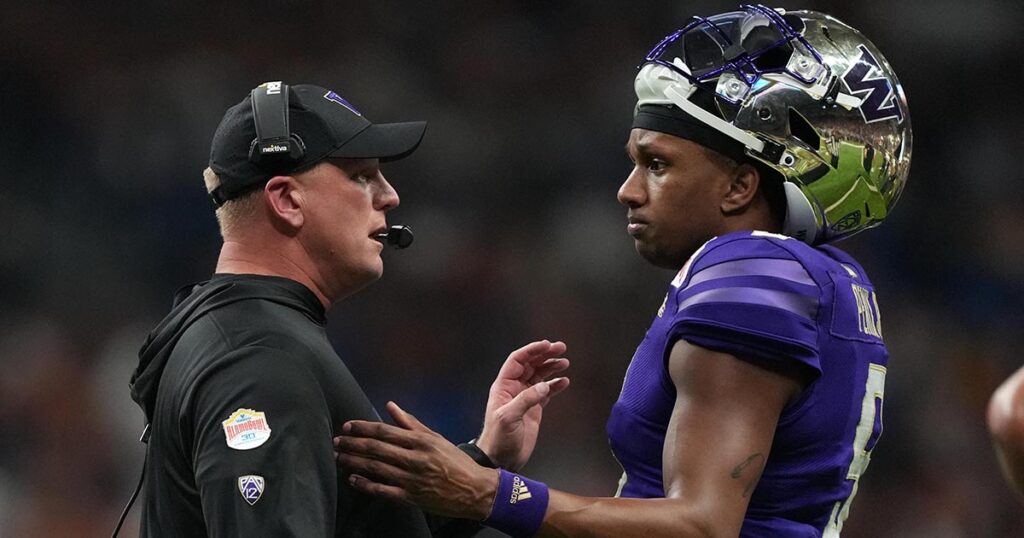College Football Playoff Preview: Pressing questions for a potential fireworks Sugar Bowl between Texas-Washington
The football gods have blessed us with an amazing set of College Football Playoff Semifinals, as both the Rose Bowl and Sugar Bowl project to be two of the most competitive games we’ve seen as we wave goodbye to the four-team format.
There is no inevitable champion in 2023.
Michigan, Alabama, Washington and Texas all have paths to winning a national title.
And that’s awesome.
These are two juicy matchups featuring all sorts of storylines, X-factors and narratives galore.
Yesterday, I previewed the Rose Bowl, and today, I offer my pressing questions — not necessarily the most basic inquiries but particulars I’m most curious about — for the Sugar Bowl between the Longhorns and Huskies.
While the Rose Bowl figures to be a physical slobber knocker, the Sugar Bowl could feature all sorts of fireworks with the offensive prowesses of head coaches Steve Sarkisian and Kalen DeBoer.
Given that both these staffs have had over a month to prepare? Giddy up.

Can Quinn Ewers out-duel Michael Penix Jr.?
Washington has the better and more consistent quarterback, as Penix has been one of the nation’s best all season. He threw for over 4,200 yards and averaged over 9.1 yards per attempt.
But unlike most of Washington’s opponents the last two seasons, the Longhorns have the luxury of having a gunslinger who can match bullets with Penix Jr.
On his best day, Ewers can be as good as any quarterback in the country, and notably, he’s had his top performances in Texas’ biggest games the last two seasons (twice against Alabama, twice against Oklahoma) and in the Big 12 Championship.
Well, the Sugar Bowl will be the biggest game of Ewers’ career.
Both teams have superb play-callers and exceptional skill talent, so if Ewers can go mano-a-mano with Penix (while avoiding a costly turnover), then Texas likely reaches the national championship game.
Will Texas’ red zone blues prove problematic?
Thanks to Steve Sarkisian’s scheme and play design, the Longhorns are a buzzsaw between the 20s, but despite the talents of Xavier Worthy, Adonai Mitchell, JT Sanders and others, Texas routinely boggles down in the red zone.
The Longhorns rank 90th in red zone scoring (80%), and their TD percentage is even worse, checking in at 49% — good for 121st in the country.
For a game that’s projected to be a shootout, Texas can’t squander scoring chances — especially deep in Washington territory. The Longhorns did go 5-5 in red zone scoring opportunities in the Big 12 Championship Game against Ok. State, so perhaps they found some solutions.
If not, it could prove the difference in the game.
Can Washington’s Joe Moore Award-winning OL consistently block T’Vondre Sweat and Byron Murphy?
In this very matchup a year ago, Washington’s OL swallowed up Texas’ front seven in the Alamo Bowl, creating enough run lanes (158 yards) and time for Penix to throw. That unit has only gotten better in 2023, but so has Texas’ D-line.
This fall, Sweat and Murphy emerged as college football’s version of Marcus Stroud and John Henderson during the heyday of the Jacksonville Jaguars, two dominant interior linemen capable of completely wrecking a game. Sweat won the Outland Trophy as the nation’s best DL, while Murphy was awarded the Big 12 Lineman of the Year.
Top 10
- 1Breaking
Billy Napier
Close to new head coach job
- 2New
Florida lands OC
Jon Sumrall scores big
- 3
Alex Mortensen
UAB hires as head coach
- 4Hot
Kalen DeBoer
Addresses Penn State rumors
- 5Trending
Game Picks
Championship Week best bets
Get the Daily On3 Newsletter in your inbox every morning
By clicking "Subscribe to Newsletter", I agree to On3's Privacy Notice, Terms, and use of my personal information described therein.
Texas had the nation’s No. 5 run defense, and the two tackles combined for 54 hurries and eight sacks.
Penix has been next-to-impossible to sack this season (just 11 times), but Oregon State and Washington State did a nice job pushing the pocket inside at times and making the Heisman Trophy runner-up uncomfortable. Interior pressure is a quarterback’s worst nightmare, so if Washington is unable to corral Sweat and Murphy, then the Huskies’ high-powered offense could get stymied.
Dillion Johnson emerged as a real factor for the Huskies over the last month of the season, but I’m not sure how much Washington is going to try to run the ball at Sweat and Murphy. Instead, if its sturdy OL can hold up, they may rely on Penix’s quick-release and screen game instead.
Which secondary proves the most susceptible?
This matchup is fascinating because both teams have obvious holes on the back end that each will target.
Despite Texas’ overall talent and athletic advantages, Washington isn’t the ideal matchup for the Longhorns because their ultimate weakness plays right into the Huskies’ strength. And visa versa.
Texas’ secondary is leaky (94th nationally) and susceptible to allowing explosive plays. The Longhorns do create turnovers (16 interceptions), but they were 90th nationally in giving up gains over 30 yards.
That’s a recipe for disaster going up against Rome Odunze, Jalen McMillan and Ja’Lynn Polk. Washington was second-only to LSU in passing plays over 20 yards and 30 yards.
But Washington’s secondary is just as suspect. While the Huskies faced better passing offenses than Texas, they allowed all sorts of big plays, too.
Washington also picked off 16 passes, but the Huskies allowed 22 passing touchdowns (92nd nationally), and the most plays over 30 yards in the Pac-12 (26, 123rd in the country). Worthy and Mitchell will have chances to make plays on the perimeter, while Sanders is a mismatch inside against the middle of Washington’s defense.
So which unit can avoid giving up the game-changing plays?